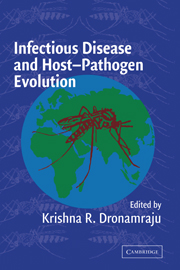Introduction
Published online by Cambridge University Press: 10 August 2009
Summary
The subject of infectious disease has never before been so intricately linked to our daily lives as it is today. Recent political and social events have underscored the importance of understanding the forces that have shaped, and continue to shape, the evolution of infectious diseases and their underlying genetic basis. The following chapters discuss infectious disease from an evolutionary perspective within the context of the occurrence of genetic polymorphisms in human populations. It was my mentor, J. B. S. Haldane (1949a, 1949b), who first drew attention to the significant role infectious diseases have played in shaping our own evolution.
Haldane's idea was the culmination of long years of investigation into the fundamental nature of evolutionary forces that have shaped the biology of all species on this planet (Haldane 1924, 1932). He was one of the great trio of founding fathers of population genetics, the two others being R. A. Fisher and S. Wright. Haldane and Fisher were also pioneers in human genetics. Haldane contributed quite profoundly to pedigree analysis and gene mapping, as well as to the estimation of mutation rates, selection effects and other branches of human population genetics, and the impact of genetic knowledge on our ethical outlook (Dronamraju 1990, 1995).
In his often-quoted paper, entitled “Disease and Evolution,” Haldane (1949b) wrote: “… the struggle against disease, and particularly infectious disease, has been a very important evolutionary agent, and that some of its results have been rather unlike those of the struggle against natural forces, hunger, and predators, or with members of the same species.
- Type
- Chapter
- Information
- Infectious Disease and Host-Pathogen Evolution , pp. 1 - 8Publisher: Cambridge University PressPrint publication year: 2004
References
- 1
- Cited by



